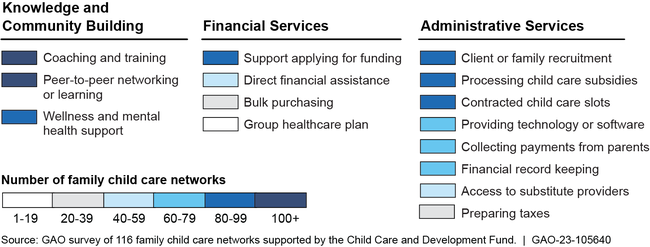Family Child Care Networks: Actions Needed to Better Assess Quality Improvement Efforts
Fast Facts
The Department of Health and Human Services' Child Care and Development Fund is the primary source of federal funding for increasing low—income families' access to quality child care.
States must use some of this money to improve the quality and availability of child care for all families. As part of this effort, states fund family child care networks, which offer services like coaching and training to home-based child care providers.
However, it is difficult to know if states' efforts to improve the quality of child care are working. We recommended that HHS help states develop performance measures and report on them.

Highlights
What GAO Found
Family child care networks (i.e., networks) are community-based programs that support family child care providers. As of March 2022, 142 networks received federal funds through the Child Care and Development Fund (CCDF). Over 80 percent of the 116 networks that responded to GAO's survey reported having funding sources in addition to CCDF, such as parents, state and local governments, and the Head Start program. All of the 116 networks serve licensed providers, and more than half also serve child care center providers or license-exempt family, friend, and neighbor providers. The most commonly offered services are coaching and training, and peer-to-peer networking and learning, according to respondents. Fewer respondents reported offering certain administrative services, such as financial recordkeeping or tax preparation.
Services That Family Child Care Networks Reported Providing in 2022

Note: For more details, see fig. 6 in GAO-23-105640
Stakeholders GAO interviewed, including state agencies, networks, and provider unions, reported that networks offer providers benefits such as improved relationships and financial advantages. However, stakeholders also cited perceived disadvantages for providers who join networks. For example, providers may associate networks with decreased independence due to activities such as additional home visits.
The Administration for Children and Families' Office of Child Care (OCC), which administers the CCDF program, provides states with resources, training, and technical assistance on networks. OCC collects some information from states on their CCDF-supported efforts. However, GAO found that OCC does not fully assess or report on states' progress toward improving child care quality, due in part to limitations in states' OCC-approved performance measures. For example, of the 13 states with networks, five did not clearly describe the measures related to infant and toddler child care quality in their OCC-approved state plans and 12 did not include measurable targets. OCC does not give states written guidance on setting useful performance measures because it believes the individualized technical assistance states may request is more effective. However, by proactively providing written guidance to states and assessing and reporting on states' progress, OCC will be better positioned to inform Congress on whether CCDF-supported efforts are meeting their goals.
Why GAO Did This Study
The declining number of family child care providers, who care for children in home settings, may cause hardships for families who depend on this type of care. Family child care networks help these providers manage and enhance the quality of their businesses.
GAO was asked to review the characteristics and perceived benefits and disadvantages of family child care networks, among other issues. This report examines (1) characteristics of CCDF-supported networks including their funding, service population, and services; (2) selected stakeholders' views on whether and how providers benefit from networks and on factors providers consider in deciding whether to join a network; and (3) how OCC supports and assesses states' efforts to improve the quality of family child care, including through networks.
GAO conducted a non-generalizable survey of CCDF-supported networks and interviewed state, union, and network officials in four states (Alabama, Illinois, Massachusetts, and Oregon), selected based on the percentage of children receiving CCDF-subsidized care in family child care homes, among other factors. GAO also reviewed states' plans and interviewed OCC officials to assess OCC's support and evaluation.
Recommendations
GAO is making two recommendations to OCC: (1) provide written guidance to states to improve their performance measures, and (2) assess and report on states' progress in improving child care quality. HHS agreed with the recommendations.
Recommendations for Executive Action
| Agency Affected | Recommendation | Status |
|---|---|---|
| Office of Child Care | The Director of OCC should provide written guidance to states on developing performance measures for CCDF quality activities that reflect appropriate attributes of successful performance measures, such as linkage to goals, clarity, and measurable targets. (Recommendation 1) |
HHS agreed with this recommendation and identified steps to implement it. Specifically, HHS said that OCC will further support more effective performance measures by providing training and technical assistance to grant recipients on how to develop effective benchmarks and performance measures that include goals, clarity, and measurable targets. As of January 2025, HHS reported that OCC was continuing to revise the form for CCDF State Plans - in which states specify their performance measures - to clarify what states must submit and help states produce better performance measures. As of August 2025, HHS reported that OCC was exploring the possibility of developing written guidance on the performance measures with a focus on how to set goals with measurable targets that promote positive child and system outcomes.
|
| Office of Child Care | The Director of OCC should assess and report to Congress and the public on states' progress in improving the quality of child care. For example, OCC could provide Congress with the number of states that met their targets for their selected quality activities as established in their CCDF plans. (Recommendation 2) |
HHS agreed with this recommendation and identified steps to implement it. Specifically, HHS said that OCC will explore strategies for conducting analysis and reporting to Congress on states' progress toward setting and achieving meaningful quality improvement goals, using available data and resources from existing administrative data collections. As of August 2025, HHS reported that OCC was continuing to explore data sources for assessing and reporting on states' progress in improving the quality of child care.
|
